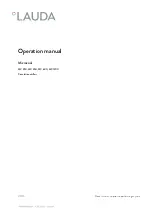
Quantech
29
Form QTC4-NM2
Issue date: 05/12/2023
4
Section 4 - Installation
Location requirements
For optimum performance and trouble-free service, it
is essential that the installation site meet the location
and space requirements for the model being installed.
It is important to ensure that the minimum service
access space is maintained for cleaning and mainte-
nance purposes.
Outdoor installations
The units are designed for outdoor installation and
can be installed at ground level on a suitable flat level
foundation easily capable of supporting the weight of
the unit, or on a suitable rooftop location. In both cases
an adequate supply of air is required. Avoid locations
where the sound output and air discharge from the unit
may be objectionable.
Select a location with minimum sun exposure, away
from boiler flues and other sources of airborne chemi-
cals that could damage the condenser coils and steel
parts of the unit.
Locate the chiller control panel in a physically se-
cured area with access only for authorized person-
nel. To further tighten security, ensure that the con-
trol panel is mechanically locked. Remove the keys
to the control panel and store them in a secure loca-
tion. If located in an area accessible to unauthorized
persons, steps must be taken to prevent access to the
unit by means of a protective fence. This helps to
prevent the possibility of vandalism, accidental dam-
age, or possible harm caused by unauthorized removal
of protective guards or opening panels to expose rotat-
ing or high voltage components.
For ground level locations, the unit must be installed
on a suitable flat and level concrete base that extends
to fully support the two side channels of the unit
base frame. A one-piece concrete slab, with footings
extending below the frost line is recommended.
To avoid noise and vibration transmission, do not se-
cure the unit to the building foundation.
On rooftop locations, choose a place with adequate
structural strength to safely support the entire operat-
ing weight of the unit and service personnel. The unit
can be mounted on a concrete slab, similar to ground
floor locations, or on steel channels of suitable strength.
Space the channels with the same centers as the unit
side and front base rails. This allow you to fit vibra-
tion isolators if required. Isolators are recommended
for rooftop locations.
Mounting holes (5/8 in.) are provided in the base rails
for bolting the unit to its foundation. See
lator selection and mounting locations on page 78
for location of the mounting holes.
Any ductwork or attenuators fitted to the unit must not
have a total static pressure resistance, at full unit air-
flow, exceeding the capability of the fans installed in
the unit.
The condenser fans are propeller-type and are not
recommended for use with ductwork, filters or other
impediments to airflow in the condenser air stream.
If you need to surround the units in addition to the op-
tional louver package selected, ensure that the screen-
ing passes the required chiller CFM without exceeding
0.1 w.g. (24.9084 Pa) external static pressure.
For protection against corrosive environments, order
the units with cured epoxy-coating on the microchan-
nel condenser coil. Use epoxy-coated coils with any
units that you install in coastal areas where salt spray
or mist may hit the units, or where acid rain is preva-
lent.
On installations where winter operation is intended and
snow accumulations are expected, additional elevation
must be provided to ensure normal condenser air flow.
Avoid locations near windows or structures where
normal operating sounds may be objectionable.
Location clearances
Adequate clearances around the units are required for
the unrestricted airflow for the air-cooled condenser
coils and to prevent re-circulation of warm discharge
air back onto the coils. If these clearances are not main-
tained, airflow restriction or recirculation can cause a
loss of unit performance, an increase in power con-
sumption, and may cause the unit to malfunction. Con-
sider the possibility of down drafts, caused by adjacent
buildings, which may cause recirculation or uneven
unit airflow.
For locations where significant cross winds are expect-
ed, such as exposed rooftops, install an enclosure of
solid or louver type to prevent wind turbulence inter-
fering with the unit airflow.
When units are installed in an enclosure, the enclosure
height cannot exceed the height of the unit on more
Summary of Contents for QTC40160
Page 22: ...Quantech 22 Form QTC4 NM2 Issue date 05 12 2023 This page is intentionally left blank...
Page 94: ...Quantech 94 Form QTC4 NM2 Issue date 05 12 2023 This page is intentionally left blank...
Page 100: ...Quantech 100 Form QTC4 NM2 Issue date 05 12 2023 This page is intentionally left blank...
Page 158: ...Quantech 158 Form QTC4 NM2 Issue date 05 12 2023 This page is intentionally left blank...
Page 187: ...Quantech 187 Form QTC4 NM2 Issue date 05 12 2023 This page is intentionally left blank...
















































